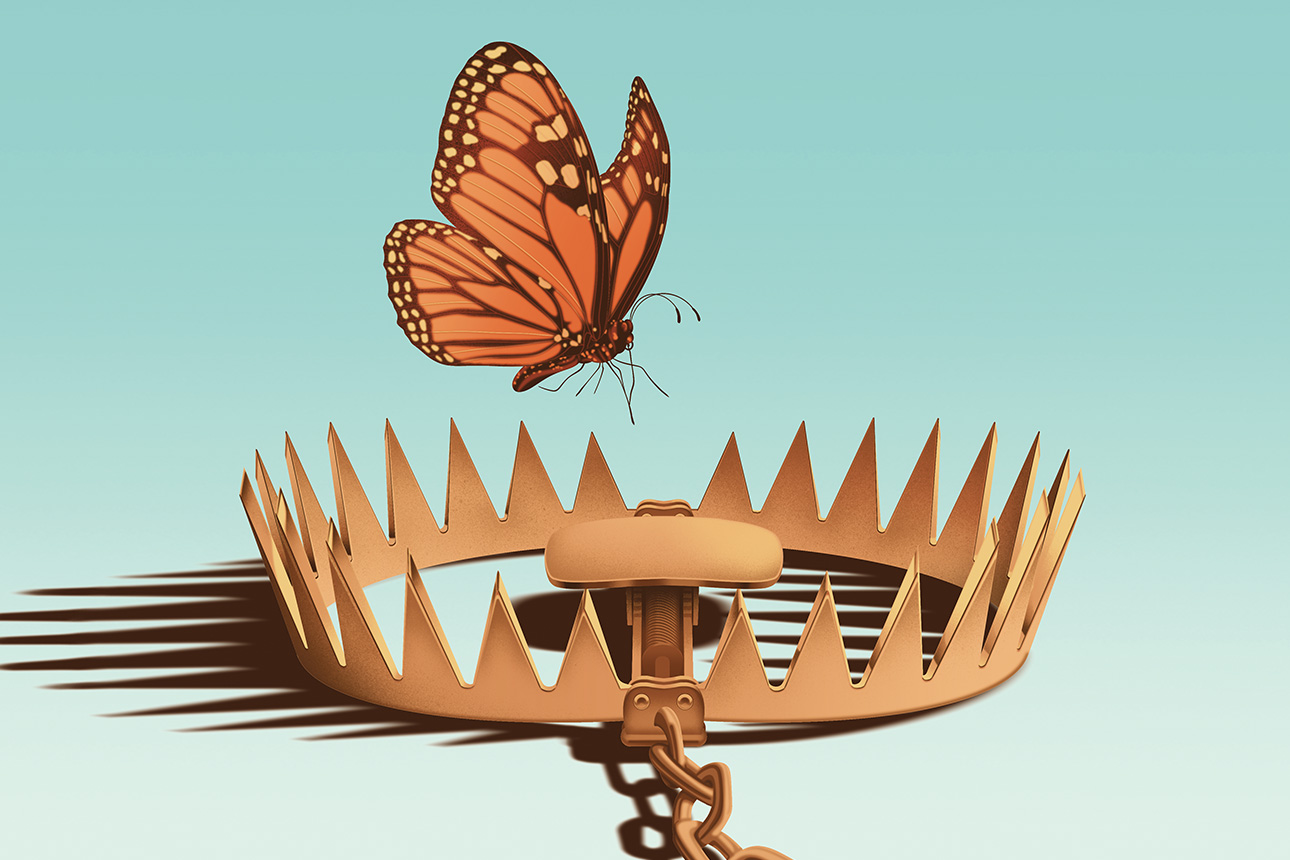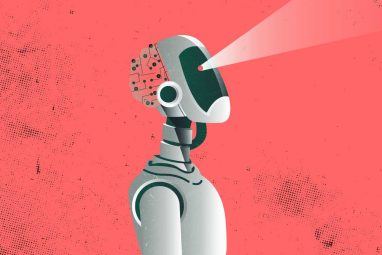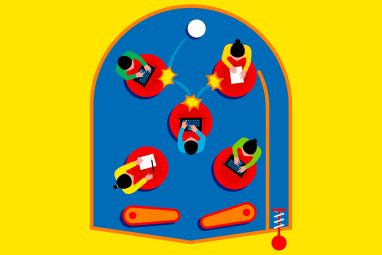The Three Traps That Stymie Reinvention
Organizational identity, architecture, and collaboration can be either assets or liabilities to pursuing growth in new sectors.
Topics
News
- More than 80% of Saudi CEOs adopted an AI-first approach in 2024, study finds
- UiPath Test Cloud Brings AI-Driven Automation to Software Testing
- Oracle Launches AI Agent Studio for Customizable Enterprise Automation
- VAST Data and NVIDIA Launch Secure, Scalable AI Stack for Enterprises
- How Machine Identity Risks Are Escalating in AI-Powered Enterprises
- How Agentic AI Is Reshaping Healthcare

Nash Weerasekera
Steve Jobs walked onto the Macworld stage in San Francisco on Jan. 9, 2007, and announced, “Today, Apple is going to reinvent the phone.” He promised that the first-generation iPhone would be available for purchase in just six months — but the prototype Jobs held in his hand was far from a finished product. His team was still working on developing a more durable touchscreen for the smartphone. Although glass was one option, Apple had been unable to find a material that did not shatter when the phone was dropped.
Immediately after the presentation, Jobs called Wendell Weeks, CEO of Corning, the company that Thomas Edison had engaged to create the glass encasements for the world’s first light bulbs. Jobs gave Weeks just a few days to decide whether Corning would partner with Apple to develop a durable glass touchscreen. For Weeks, such a commitment would mean redirecting critical resources and 300 people away from the company’s successful LCD business, a division delivering much-needed cash flow. He also noted a palpable fear of failure, telling me later, “There were some in the company who thought what Jobs wanted was an impossibility. If we took this on and failed, Jobs would turn Corning into a pariah because we would have been the ones who stopped the iPhone.”
Corning’s dilemma — how and when to divert limited resources and know-how to an unproven new product line — represents a common reinvention challenge that most organizations face at some point. When successful, reinvention can lead to breakthrough innovations like Gorilla Glass, the product that emerged from Corning’s decision to partner with Apple and has since been used in over 8 billion devices by more than 45 major brands.
In more than a decade of researching innovation, I have observed how organizations respond to new opportunities, technological changes, or unexpected market shifts that threaten to upend their current business models. This process, which I call reinvention, may occur proactively or reactively. Corning offers a proactive example, highlighting how a continued forward focus on reinvention helped it seize unexpected opportunities, be it a request from Thomas Edison to develop the first light bulb or, a century later, from Steve Jobs to partner on the first iPhone.
More often, however, reinvention is a response to an unexpected existential threat. This form of reactive reinvention exposes dangerous traps that can derail or even bankrupt an organization. One needs to travel only 100 miles north of Corning’s headquarters to be reminded of how the iPhone’s integrated camera served as the final blow to Kodak after the company struggled for years to move beyond its once-dominant film business.
In interviews, focus groups, and workshops with 1,451 individuals who faced reinvention dilemmas across a broad array of sectors, I have found that a core challenge of reinvention is that an organization’s past success can be either the greatest asset or the chief liability to its future.
I discovered that, contrary to popular belief, organizations rarely fail to reinvent themselves because their leaders are naive about new technologies or emergent trends. Surprisingly, many of the companies I studied invented the technology that nearly killed them. Several retired Kodak executives were eager to remind me that they had developed the first patents for digital photography. Similarly, Swiss watchmakers in the 1960s developed the first quartz battery-powered timepieces that nearly decimated the mechanical watch industry.
Some organizations struggle more than others to reinvent themselves not because they overlook technological or market changes, but because they become caught in three traps rooted in their identity, their organizational architecture, and how their members collaborate. Although they often appear in a common sequence, the traps can also overlap with one another. In this article, I’ll discuss how these traps can limit a company’s ability to find new avenues for growth — and how to avoid them by laying the appropriate communications groundwork to foster a coherent identity, setting up new organizational structures, and paying close attention to interpersonal dynamics at the team and individual levels.
New Directions Force Hard Choices
Reinvention can be daunting because it forces leaders to confront trade-offs between investing in innovations for today versus the future. Established companies must decide what they should hold on to and what they should let go of in order to free up resources for future innovations. Managers must face a reckoning with their innovation capabilities and assess whether they have what’s needed to foster breakthrough innovations.
At the same time, managers need to balance innovation activities across both current product lines and new offerings. Each product or service sits on its own S-curve, moving from infancy to growth, and then to maturity; to succeed at reinvention, organizations must have the capacity to manage multiple S-curves simultaneously. (See “The Reinvention Traps.”) Prior research has shown how innovation demands different approaches at each phase.1 In the infancy phase, innovation is primarily about exploration — that is, incubating high-potential breakthrough innovations. In the maturity phase, where more established products sit on the S-curve, innovation is about exploitation, or how well the company uses its existing capabilities to add greater functionality, cut costs, or stay ahead of the competition.
Reinvention missteps occur when leaders focus on one phase of the S-curve without balancing the need to innovate in other phases as well. My research revealed a unique sequence that often emerges among the traps, described below, along with lessons leaders can use to prepare for and address each trap ahead of time.
The Identity Trap: When ‘Who We Are’ Is Too Closely Intertwined With ‘What We Do’
Organizational identity is typically the first trap to derail a reinvention effort. Not to be confused with branding or consumer marketing, identity reflects what leaders and employees agree make up the organization’s central, distinctive, and enduring characteristics. These elements define the organization and can sometimes be perceived as being threatened by new innovations.
This happens when organizational identity is too closely linked with a specific product or service. When “who we are” is really “what we do” (for example, “we are a film company that makes film”), the company risks the following innovation consequences.
Leaders pass up opportunities. Keeping the scope of innovation narrowed to a comfortable “what we do” can prevent managers from pursuing new capabilities needed for breakthrough innovations. For example, as the world shifted to e-commerce in the early 2000s, the Borders bookselling chain remained staunchly tied to its identity as a brick-and-mortar retailer. When Jeff Bezos offered to help build the company’s e-commerce platform, leadership remained focused on the business of running a chain of bookstores and elected to outsource e-commerce to Amazon.
Seven years later, when the Borders team realized that the company needed to develop its own e-commerce capabilities, it was too late. Without a clear identity to guide a multichannel expansion strategy and new product offerings, the company lost its way and eventually filed for bankruptcy. According to cofounder Tom Borders, “The company forgot that selling books is not the same as selling sausage or socks.”2
Faced with the same existential threat from Amazon, many independent bookstores across the U.S. have avoided the identity trap by adopting a broader definition of who they are: community gathering places and leaders of the “shop local” movement. This more expansive identity has helped them redefine the in-store experience, leading independent booksellers to experiment with hosting author events, curating inventory to local tastes, and educating customers about the importance of supporting local businesses.3 As a result, the number of independent bookstore locations increased by 72% from 2009 to 2024. They have survived because their identity helped them develop a novel service model that invited customers into the physical store to participate in a community-based experience. It’s an experience Amazon’s algorithms have been unable to replicate.
Employees resist change. A narrow identity also contributes to organizational inertia that can cause employees to resist or reject exploration activities on new S-curves. “No thanks — that new innovation is not who we are” was a common refrain I heard in interviews with employees of failed reinvention efforts.
The identity trap is especially relevant in organizations that have well-established offerings — often ones that employees take great pride in. In one study, my coauthors and I found that narrower definitions of identity can lead individuals to reject breakthrough innovations, especially if they worry that the new product or service will render their knowledge or skills obsolete.4 But a more expansive sense of organizational identity can help employees be more open to change.
Consider the challenge that faced Moleskine, a Milan-based company that has sold millions of its iconic oilskin-covered notebooks. The company had to make a critical decision about whether to pursue digital note-taking solutions that were emerging as an alternative to physical notebooks. Rather than resisting these trends, Moleskine partnered with Evernote and Adobe — and found that its employees embraced the new direction.
Moleskine cofounder Maria Sebregondi credited their support to Moleskine’s long-standing organizational identity. The founding team never saw themselves as building a notebook company; instead, she told me, they saw themselves as “creating tools for the creative mind.” She frequently communicated this identity to employees, encouraging them to develop products for personal expression that would “capture ideas, experiences, and dreams.” Thus, when Moleskine extended its product vision to digital note-taking, employees saw it as a natural extension of the company’s vibrant creative identity.
To avoid the identity trap, leaders need to communicate a modestly abstract identity before setting out in a new direction. The leader’s task is to preemptively frame the organization’s identity in broad-enough terms that both new and mature products or services are seen as relevant to employees’ understandings of “who we are.” A broader identity can tie multiple products and services together and can help employees see breakthrough innovations as opportunities rather than threats. Leaders should avoid narrow identity claims associated with a specific product (“we sell books”) or an identity that becomes meaningless because it’s too generic (“we are a world-class innovation company”). When possible, managers should begin to communicate an identity change long before new products are about to displace the old. They should build in more time to redefine “who we are” if a specific product or service has become synonymous with the organization’s identity.
The Architecture Trap: When Innovation Structures and Incentives Are Misaligned
The second reinvention trap occurs when leaders don’t rethink elements of organizational architecture — team structures, levels of hierarchy, work processes, and reward systems — to align with the different types of innovation demanded to create breakthrough products as opposed to improving on existing ones. Early-stage innovation teams may need more flexible work structures to navigate uncertainty and conduct experiments, as well as different incentives. Improving or expanding existing product lines and services, on the other hand, requires formal systems and structures to identify process improvements, test incremental product changes, or squeeze out efficiency gains.
Management research has recognized the need for separate organizational architectures to support exploration and exploitation activities.5 Both are necessary for reinvention, but they are almost always in tension. Building on this work, I found that leaders tended to underestimate the need for multiple architectures to support processes at different stages of the S-curve, with the following consequences.
Innovation structures aren’t fit for their specific purpose. Leaders may unwisely rely on similar architectures to accomplish too many innovation goals. I watched leaders at a high-growth technology company establish teams with the mandate to explore a new disruptive app for food delivery, but they then assumed that an early-stage incubation architecture would be suitable for scaling the product and integrating related operations into the main line of business. Likewise, at a large department store chain, I saw a leader develop an architecture to support revenue-generating innovations for mature products, then ask the same teams to incubate radically new processes and technologies in their spare time. Without the bandwidth or autonomy to experiment, the existing formal hierarchy suffocated the new S-curve for breakthrough innovation.
In contrast, Corning’s structures and processes have fostered many breakthrough innovations since the company’s founding in 1851, including the heat-resistant glass it marketed as Pyrex, optical fiber, and glass substrates for LCD screens. When Weeks agreed to develop a durable glass screen for the iPhone, he had to quickly divert resources and scientists from the company’s mature business supplying glass to LCD television and display manufacturers. Later, the company began to explore other applications for Gorilla Glass. Weeks extended the company’s innovation architecture by creating an Emerging Innovations Group (EIG) to accelerate the pace at which the company converted traditional research into commercial products. The group, located in the company’s R&D laboratories, gives its members autonomy, flexibility, and time to incubate product ideas before turning them over to the commercial business units, according to Corning innovation officer Marty Curran. Once the EIG demonstrates that a potential product has commercial potential, business-unit managers bring the new revenue-generating products under their purview. Over the past several years, the EIG has transitioned several Gorilla Glass technologies into products for automobile manufacturers, including touch-sensitive dashboards and consoles, safer and lighter windshields, and augmented reality heads-up display systems.
Incentives aren’t balanced across innovation areas. Leaders should give thought to what incentives are appropriate to specific innovation activities. Distinct incentives should reinforce the unique behaviors required for breakthrough innovation as opposed to incremental product development. R&D employees working on early-stage innovations may prefer recognition for solving technical problems, whereas an innovator developing a product-line extension may be driven by incentives that reward commercial success. Avoid creating incentive systems that offer outsized rewards to one group but no such opportunities for others.
It is important to communicate that innovation is critical at all phases, even if it takes different forms. Successful reinvention starts when organizations seed breakthrough ideas well in advance of the decline of a mature product or service. In turn, early-stage exploration also relies on the organization’s ability to kill off less promising innovation projects in the infancy phase of the S-curve. At Corning, breakthrough innovation teams are incentivized to kill projects before they go to market and become more costly to unravel. At an annual “Day of the Dead” event, employees invite leaders from across the company to celebrate terminated projects that didn’t show commercial promise. Everyone eats cake and toasts the projects they killed. Likewise, reinvention also requires a clear commitment (and different incentives) for continuous innovation of existing products.
The Collaboration Trap: When Divergent Goals Damage Mutual Trust
The collaboration trap emerges when individuals or groups fail to develop productive, trusting relationships that support the value everyone brings to the organization.
Individuals may see themselves contributing to different goals when assigned to products or services at different phases of the S-curve, but those different objectives can breed rivalry.
If leaders fail to manage perceptions around different resources for different groups, or to communicate that all innovation efforts are valued and contribute to the company’s success, resentment and competitiveness may grow. Individuals assigned to mature products or services may begin to resent colleagues with access to cutting-edge technologies or additional resources. They may feel that their peers don’t have to play by the same rules. Such perceived inequities can lead to infighting or turf wars that stop people from learning and sharing information. I observed how one CEO’s overzealous appetite for breakthrough innovations threatened to demoralize individuals working on other teams that were focused on more incremental improvements. Over time, this lack of recognition created a perception of favoritism that eroded trust among the teams.
Likewise, if some employees see themselves solely as guardians of the past while others believe their only concern is innovating for the future, a lack of shared goals may foster distrust. Divergent objectives limit the perceived need to build mutually trusting relationships. Interactions become less frequent, and neither side benefits from the expertise of others.
As a counterpoint, in a historical study of the Swiss watchmaking industry, my coauthors and I observed how two leaders with divergent visions overcame the collaboration trap by not only reinventing their organization but shaking up the entire Swiss watch industry.6 In 1983, facing fierce competition from Japanese battery-powered quartz watch technology, Nicolas G. Hayek, CEO of Swatch Group, proved to be a transformational figure untethered to traditional mechanical watchmaking. He embraced the new quartz technology and launched the casual Swatch watches that swept the globe as affordable fashion timepieces. Meanwhile, Jean-Claude Biver, an advocate of high-end mechanical craftsmanship, purchased the rights to the fabled Blancpain watch brand and advocated a view of the future that honored and preserved the Swiss watchmaking tradition.
The two perspectives seemed entirely at odds, yet, during the 1990s, the two men chose to work together after Hayek acquired Biver’s company. Rather than battling over opposing visions, they met early each morning to work through strategic and tactical challenges. Biver benefited from Hayek’s mastery of modern manufacturing processes, and Hayek from Biver’s marketing genius. Importantly, they created a shared space to work on joint initiatives, and they often shared the stage at press events to revive the then-struggling Omega watch brand.
Trust and collaboration between the two leaders led to a shared vision through which the company modernized its mechanical watchmaking processes to be more efficient while also improving the design esthetics of its quartz watches. Ultimately, Swatch Group became the world’s largest watch company, as well as the largest supplier of components to the rest of the Swiss watchmaking industry.
Getting out of the collaboration trap requires proactive effort on the part of managers. One project my team observed ran into trouble when two middle managers crossed swords over whether burgeoning ideas would divert too many resources from preexisting product lines. To address the disconnect, the head of product innovation hosted a daylong workshop on the behind-the-scenes science of product development. A subsequent series of cross-functional workshops created a shared space for specialists to temporarily enter one another’s domain, expanding their vision and helping them identify points of compromise.
Leaders should seek to create opportunities for joint decision-making and idea exchanges among innovation teams working at different phases of the S-curve. More frequent interactions can help each side address emergent tensions, inflated egos, or misplaced assumptions before they balloon into larger disagreements. If team members don’t appreciate the need to balance the organization’s multiple innovation programs, reciprocity and mutual trust can erode. To reduce such tensions, create shared spaces that allow leaders to empathize with and learn from one another. Shared spaces and shared activities enable them to build reciprocal trust and dialogue about what each side can learn from the other. Doing so also requires that they admit to personal limitations and prior mistakes. This means accepting help and acknowledging the value each party brings to the full enterprise.
Another strategy to build trust and collaboration, and reduce turf wars, is to temporarily reassign employees to work on teams at other phases of the S-curve. Treat the assignments like short-term sabbaticals, or opportunities to learn about a new part of the business without the same expectations for performance in one’s “home” business unit. Doing so will help the cynics gain insight into the company’s innovation activities. For example, if guardians of the past feel that they are part of the future, they are more likely to become emissaries who can share positive news with colleagues in the main-line business about what lies ahead. Likewise, individuals who incubate early-stage products and services can gain knowledge about how to eventually transition pre-commercial innovations to the main-line business. Consider these stretch assignments, where individuals walk in one another’s shoes to gain a deeper appreciation for others’ innovation goals and challenges.
References
1. W.K. Smith and M.L. Tushman, “Managing Strategic Contradictions: A Top Management Model for Managing Innovation Streams,” Organization Science 16, no. 5 (September-October 2005): 522-536.
2. T. Borders, “From Local, to Global, to Gone: On the Rise and Fall of Borders Books,” in “Among Friends: An Illustrated Oral History of American Book Publishing and Bookselling in the 20th Century,” eds. B. Teacher and J.B. Teacher (New Hope, Pennsylvania: Two Trees Press, 2023).
3. R. Raffaelli and R. Noe, “Organizational Emplacement as a Response to Digital Threat: The Novel Resurgence of Independent Bookstores,” working paper 23-033, Harvard Business School, Boston, December 2022.
4. R. Raffaelli, M.A. Glynn, and M. Tushman, “Frame Flexibility: The Role of Cognitive and Emotional Framing in Innovation Adoption by Incumbent Firms,” Strategic Management Journal 40, no. 7 (July 2019): 1013-1039.
5. A.K. Gupta, K.G. Smith, and C.E. Shalley, “The Interplay Between Exploration and Exploitation,” Academy of Management Journal 49, no. 4 (August 2006): 693-706.
6. R. Raffaelli, R. DeJordy, and R.M. McDonald, “How Leaders With Divergent Visions Generate Novel Strategy: Navigating the Paradox of Preservation and Modernization in Swiss Watchmaking,” Academy of Management Journal 65, no. 5 (October 2022): 1593-1622.





